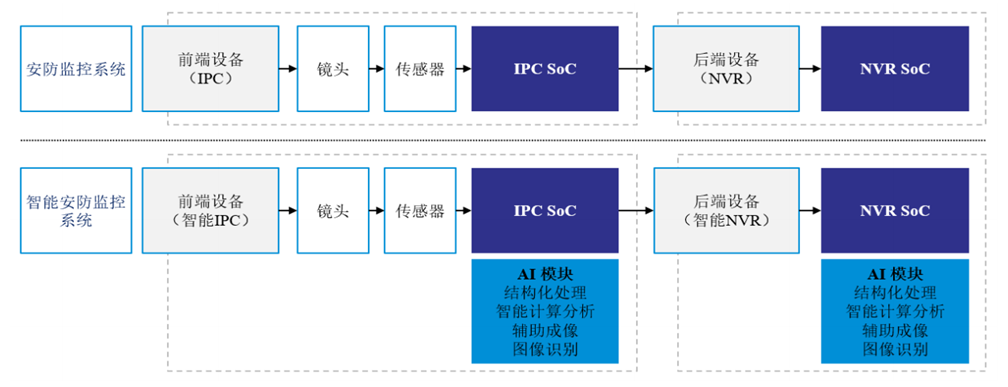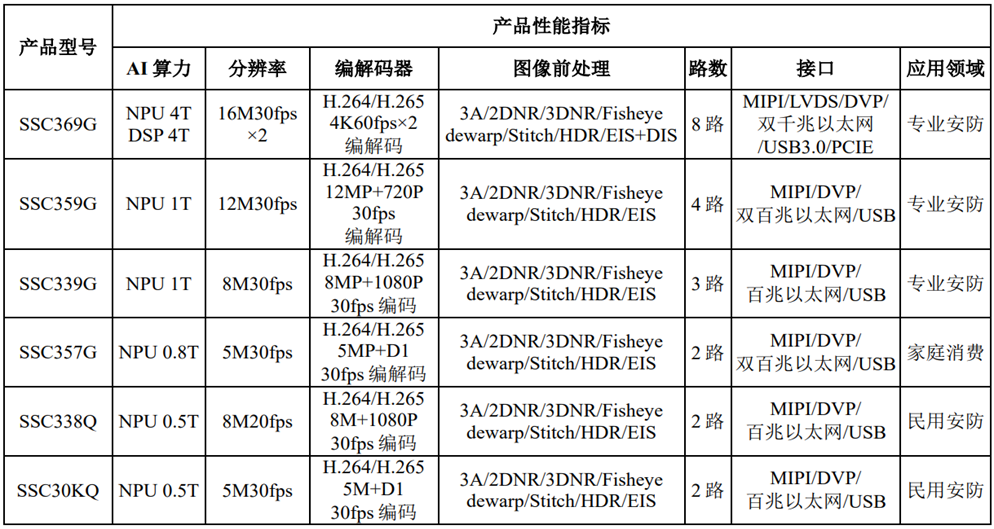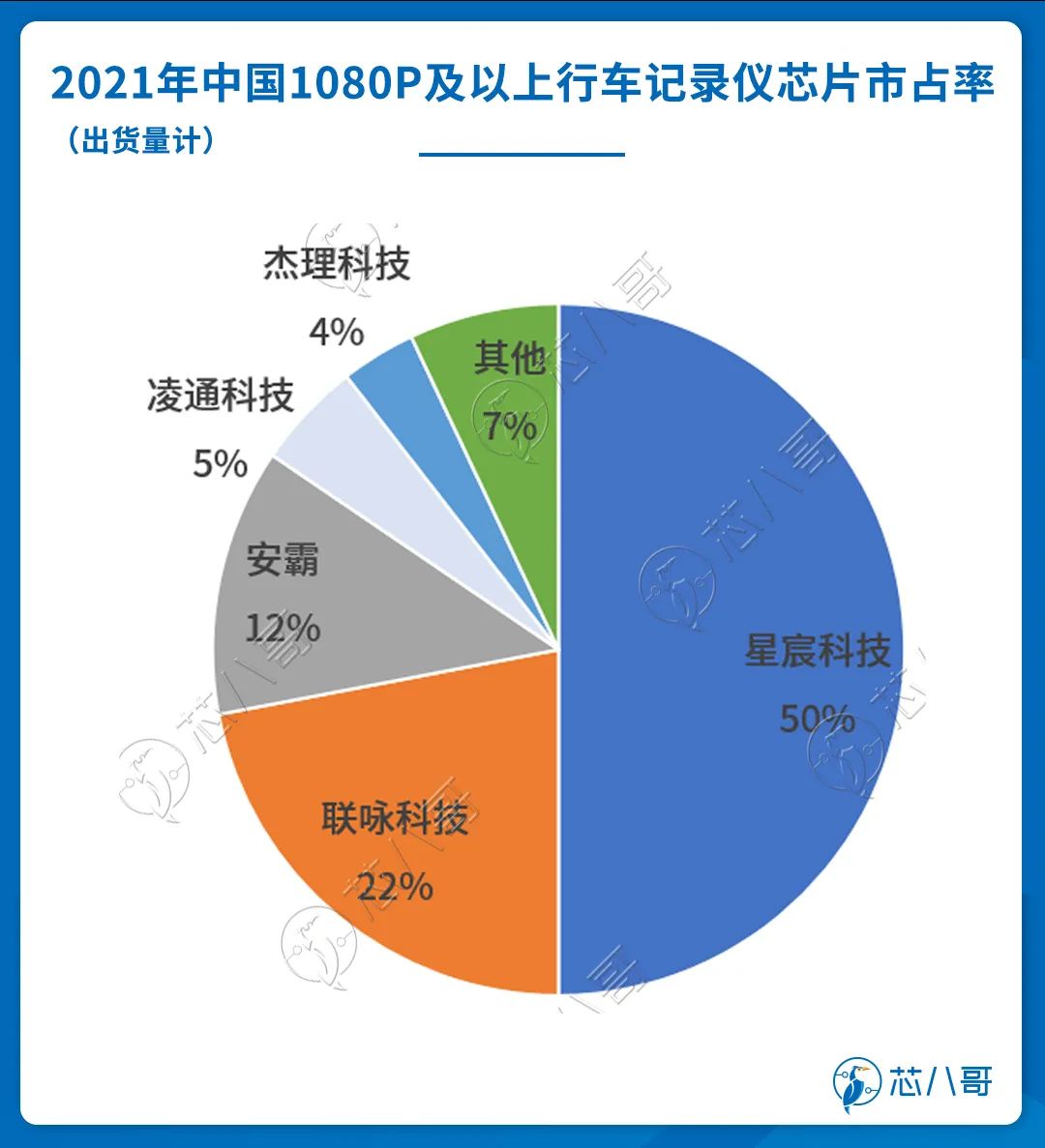Annual shipment of nearly 100 million pieces, this domestic manufacturer ranks first in multiple sub sectors
Time:2024-02-04
Views:425
Source: Octopus Core Author: Joey
The explosive popularity of the Open AI "Chat GPT" model has driven a shortage of cloud training/inference chips led by Nvidia.
After taking the lead in the cloud, various new technologies, products, and applications of AI are constantly emerging in the industry, and have gradually settled on the edge and end sides, accelerating their landing.
As a leading global security chip enterprise, Xingchen Technology was established in 2017 and has always focused on the strategic layout of the five core IPs of video, audio, display, connectivity, and AI. Based on the optimistic outlook for the future development of AI, the company has established an AI team since its establishment to carry out independent research and development of AI chips and a complete toolchain.
In 2018, Xingchen Technology launched its first AI SoC chip. In 2019, the company held its first "leading AI everywhere" product launch event. In the booming year of AI in 2023, Xingchen Technology held this event for the third time and launched multiple series of new products in the fields of security, automotive, robotics, etc. to continuously empower various industries with its expertise in AI technology.
Intelligent security: Shipping nearly 100 million pieces annually, far ahead of competitors
In recent years, benefiting from the promotion of policies such as "safe cities", "smart cities", and "safe rural areas", video surveillance has become a major product in the security industry to ensure social stability and public property safety, driving the continuous increase in the size of the security surveillance market.
According to Frost&Sullivan‘s data, the global security video surveillance equipment market size in 2021 was $22 billion. Under the trend of technological iteration and upgrading, as well as the sinking of the security monitoring equipment market, it is expected to grow at a compound growth rate of 6.3% in the next five years, and its market size will reach 29.9 billion US dollars by 2026.
The billion dollar market for security monitoring equipment has attracted many chip players such as Huawei Hisilicon, Lianyong, Anba, Fuhanwei, Beijing Junzheng, Ruixin Micro, and Guoke Micro to layout. As a latecomer, with strong support from major shareholders such as MediaTek, Xingchen Technology surpassed Hisilicon in just a few years, achieving a record revenue of 2.686 billion yuan in 2021, and becoming a global leader in the security industry with a 36.5% market share of IPC SoC.

Source: Frost&Sullivan
However, traditional monitoring in the past could only rely on intelligent processing and analysis in the cloud, which caused significant pressure on data transmission and cloud computing storage. At the same time, the real-time performance of the product was not guaranteed. To address this pain point, AI technology has entered the field of video surveillance as a new technological transformation element. It is understood that the intelligent security chip that combines video surveillance chips with artificial intelligence can process a large amount of unstructured data more efficiently, making the chip‘s understanding of video content more thorough, thereby helping traditional video surveillance achieve intelligence from "clear" to "understandable" and "fast", from "post search" to "pre prevention decision-making" and "mid event alarm".
Based on the above concept, Xingchen Technology continuously iterates the level of AI technology on the basis of existing AI IPC SoC products, enabling the products to have sufficient computing power in the front-end and providing an efficient operating environment for algorithms and applications; At the same time, the company continuously provides computing power support for deep analysis, big data collision, and retrieval of massive videos, images, data, and other content at the edge and center, thus forming a highly intelligent computing power support for the entire network of end, edge, and cloud. Up to now, Xingchen Technology has sold nearly 100 million intelligent security chips annually, far ahead of other competitors.

Security monitoring system scheme
Source: Xingchen Technology
He Xiaoming, the person in charge of Xingchen Technology‘s intelligent visual product line, said that intelligent upgrading can greatly help video monitoring chips improve video information processing efficiency and accelerate the transmission speed between modules. It is the main theme of the current development of the security industry and the main direction and trend of future development. After experiencing initial sprouting and market exploration, we believe that AI security has officially entered the second half stage, and there will be more new technologies involved in the future around the goal of improving perception ability. In terms of intelligent security SoC, Xingchen Technology is one of the few AI SoC manufacturers in the world that can simultaneously cover end-to-end and edge testing, and achieve mass production and shipment to domestic and foreign frontline security manufacturers. Of course, we are not satisfied with this. In order to continuously support the ever-changing demand for the application of security intelligence in the market, Star Technology has been constantly exploring and advancing.
Specifically, currently Xingchen Technology‘s IPC SoC products are mainly aimed at professional security, civilian security, and household consumption, providing a full range of resolutions from 1080P to 4K+and mainstream compression and decoding formats such as H.264/H.265. The main product models include SSC369G, SSC359G, SSC339G, SSC357G, SSC338Q, SSC30KQ, etc.

Specific information on the main products of the company‘s IPC SoC
Source: Xingchen Technology
Taking SSC369G as an example, this product has a unique patented design for a data pipeline from Scaler to encoder, and has ISP multiple processing technology in low light environments, which can ensure higher clarity in low light environments. It can effectively reduce the video stream bit rate while maintaining peak signal-to-noise ratio. In low light environments, clarity and peak signal-to-noise ratio, two core indicators, have obvious competitive advantages in the industry. In addition, the product has high integration, built-in ePHY, OTP, RTC, Audio codec, and supports high transmission speed and high capacity DRAM, which can meet the mainstream video CNN algorithm model needs of major customers and algorithm companies. It is worth emphasizing that the AI processor of this product has complete end-to-end capabilities, covering various differentiated applications, effectively improving AI recognition speed and accuracy, and achieving industry-leading levels of effective computing power and algorithm compatibility in actual testing.
On the basis of SSC369G, Xingchen Technology has recently launched a more versatile new generation intelligent visual processor SSC379G-S.
He Xiaoming pointed out that SSC379G-S is a new generation of intelligent visual processor from Xingchen Technology. It has powerful and rich functions, such as AV1/JHEVC/AVC the third mock examination video encoder, thermal imaging multi light source integration, DIS/EIS anti shake multi eye seamless splicing, background virtualization privacy protection, three system architecture standby plant multi-sensor access, and leads the development of industry security features to the highest security level standard of PSA L3 Ready. It is a smart home, transportation, education The best choice in various scenarios such as conferences, finance, and energy.
In addition to the performance oriented SSC379G-S, Xingchen Technology has also launched a lower power consumption SSC308QE next-generation intelligent visual processor product. According to its introduction, the product supports dual 4K multi camera applications, new generation video coding control strategy algorithms, and three system architecture standby mode multi-sensor access. It has superior image quality than industry standards, and also achieves ultra-low power consumption of the equipment, which can greatly save costs for customers.
Intelligent vehicles: with the highest market share of 1080P and above dashcam chips
In addition to security, cameras are also widely used in scenarios such as driving recorders, reverse cameras, and 360 degree panoramic cameras in cars.
It is worth noting that with the continuous development of automotive intelligence in recent years, the in car camera market has gone through a development process from single camera to multi camera, ordinary camera to intelligent camera. According to the different functional requirements and installation locations of ADAS, cameras can be divided into cabin exterior cameras and cabin interior cameras. The cabin exterior camera mainly includes front view camera, rear view camera, side view camera, surround view camera, etc. In addition to traditional camera functions, it also includes functions such as lane departure warning, vehicle collision prevention warning, side blind spot monitoring, rear crossing obstacle detection, front moving obstacle detection, sign recognition, traffic light reminder, etc; The cabin camera has functions such as fatigue detection, driver identity recognition, passenger action recognition, and residual object detection. The ADAS system that achieves L3 autonomous driving level requires at least 10 cameras, while the L5 autonomous driving level requires a higher number of cameras, which will bring huge market space for the in car camera market.
According to Frost&Sullivan‘s data, the global car camera market size was $14.36 billion in 2021, and it is expected that the global car camera market will grow at a compound growth rate of 10.3% from 2021 to 2026, reaching $23.41 billion in 2026. As the demand for car mounted cameras continues to rise, higher requirements have been placed on the encoding and decoding capabilities, image processing capabilities, and AI applications of car mounted camera chips, driving the global evolution of car mounted camera chips towards high-definition, high-end, intelligent, and multi-channel digitization, and the market size is also continuously growing. According to its prediction, the global market size of car camera chips will grow from $2.28 billion in 2021 to $8.79 billion in 2026, with a CAGR of up to 31%.

Source: Frost&Sullivan
According to Star Technology, the company had a vision at the beginning of its establishment to serve N segmented markets based on its technological capabilities.
After years of development, Xingchen Technology has achieved a leading position in the field of intelligent automotive market with its leading technological level, comprehensive product line layout, outstanding product quality, and excellent technical services. According to Frost&Sullivan‘s data, based on shipment volume, Xingchen Technology‘s market share in the Chinese dash cam chip market in 2021 was 24.0%, ranking second in the market. In addition, the company has a market share of 50.0% in the 1080P and above dash cam chip market in China, ranking first in the market. According to the company, the main customers currently include many well-known manufacturers such as FAW Volkswagen, Chery, Geely, GAC Honda, FAW Audi, Dongfeng Liuqi, Shaanxi Automobile Heavy Truck, and China National Heavy Duty Truck.

Source: Frost&Sullivan
Tang Benbing, the head of Xingchen Technology‘s smart car product line, pointed out that in terms of smart car chips, Xingchen Technology‘s development goals for products are high-definition, multi-channel, AI, and networking. At present, the company is gradually adding AI functions to its in car chips, and ISP has evolved to the third generation. The self-developed IPU also optimizes computing efficiency for intelligent applications such as driving, automatic parking, and cabin intelligent perception. The next generation ADAS chip will support the efficient implementation of large network models such as BEV+Transformer in the lumbar market. In addition, in addition to stability, reliability, and safety, we also hope to bring everyone an ultimate performance and AI efficiency chip. By building a smart in car perception computing chip platform, we can bring intelligence to every car and actively cooperate with industry partners to accelerate the differentiation and intelligence of the automotive entry-level and waist market.
Specifically, the current smart car chips of Xingchen Technology mainly include SSC8838G, SSC8629G, SAC8542, SSC8836Q, SSC8629Q, etc., which can support multiple resolutions of 1080P and above, as well as various types of interfaces such as WIFI, 4G, SATA, HDMI, USB, and Ethernet, covering product requirements of 2 million to 4K pixels. In addition, the company‘s vehicle regulations products also adopt H.264/H.265 video encoding and decoding standards, which can achieve high image quality and low bitstream transmission, and can be widely used in many fields such as driving recorders, reverse imaging, and assisted driving systems. According to the company‘s disclosure, the cumulative sales of intelligent car chips in the past three years have reached 32 million units, and the related business revenue in 2022 has reached 226 million yuan, becoming the second largest source of revenue for the company after security.



The technical characteristics of the driving recorder chip of Xingchen Technology‘s high-end intelligent car chip
Source: Xingchen Technology
Taking the SAC8542 product as an example, it adopts a CMS architecture with a delay of 40ms, only takes 1 second to start, has 0.8T AI computing power, supports 4K+2M/2K+2K+2M resolution, H.264/H.265 codec, 3DNR/WDR/HDR/LDC/EIS image preprocessing, and MIPI/DVP/USB/SDIO/HDMI/ETH interface. It is equipped with the company‘s independently developed AI processor and object detection, front car collision prevention, lane departure maintenance Traffic sign recognition and fatigue warning algorithms can achieve numerous automotive light intelligent applications.
Our strategy for in car visual perception computing scenarios is to achieve single point maximization, optimal performance, and the highest cost-effectiveness. Based on this strategy, we have launched the 8542 series products for CMS, DMS/OMS scenarios, and the 8539 series products for DVR and E-Mirror. In the future, we will also launch corresponding products such as SAC8902, SAC8950, SAC8916, SAC8A20, etc. for scenarios with higher technical requirements such as Al Camera, integrated perception and calculation of parking cabins, integrated parking cabins, and cross domain AD. We hope to empower automotive intelligent perception applications through Xingchen Technology‘s automotive grade series chips, open SDKs, AI toolchain platforms, and powerful ISP tools, so that everyone can enjoy the wonderful experience brought by automotive intelligence.
Tang Benbing said.
Intelligent robot: technical ability to move to the next air vent
With the continuous progress of modern technology, robots have achieved autonomy and intelligence to a large extent by continuously integrating new technologies such as intelligent speech, processors, AI algorithms, communication, big data, and the Internet of Things, and have accelerated penetration in various industries.
At present, there are numerous types of robots on the market, including personal/home robots represented by sweeping robots, window cleaning robots, entertainment robots, education robots, as well as professional robots represented by medical robots, venue robots, logistics robots, defense robots, and other types of robots. According to data from the China Electronics Society, the market size of service robots in China is approximately 45 billion yuan in 2022. With the accelerating trend of aging population and the demand for digital upgrading and cost reduction of enterprises, there is huge market potential and development space for service robots in China in the future.
The robotics business is strongly related to our core competencies. To excel in robotics, we believe that it requires the following core competencies: firstly, the ability to design multi-core and heterogeneous architectures. Robots are complex systems with multiple tasks and systems that need to be processed in parallel. Currently, multi-core and heterogeneous architectures are considered the most efficient in the industry for resource scheduling and allocation; Secondly, it is necessary to have the ability to provide efficient underlying computing power support. The main development direction of robots in the future is intelligence, so it cannot be separated from large computing power chips as the underlying computing power support; Thirdly, it is the ability of multi-sensor fusion. Robots are actually like humans, they require the use of sensors such as eyes, ears, touch, smell, etc. to perceive the physical world around them to complete tasks. The future development trend is definitely not just a simple stacking of sensors, but will gradually be wired and integrated.
Chen Lijing, the person in charge of the AIoT product line at Xingchen Technology, said.
Starting from industry research in 2019, the first parent-child robot solution equipped with the company‘s 9211 chip was launched in 2020. From 2021 to 2023, Xingchen Technology successively released chips such as SSC92110D/Q, SSC369G, SSU9386/SSU9383 for robot scenarios, and they have been widely used in various robot scenarios such as home and commercial use.

Roadmap of Robot SoC Chip for Xingchen Technology
Source: Xingchen Technology
Chen Lijing stated that SSU9386 is a robot SoC chip that combines visual module processing chips, large core CPU/IPU chips, MCU chips, and audio four cores. It has a computing power of up to 3TOPS and has the ability to simultaneously access and parallel process multiple CMOS/TOF/radar/ultrasonic/gyroscope/infrared/Hall sensors. This not only effectively reduces system complexity and improves research and development efficiency, but also improves system integration, security, and supply chain efficiency, Effectively reducing system power consumption and costs; The SSU9383 is equipped with an ARMCA55 quad core+network processor, supports 1.5TOPS computing power, and can support up to 2 CMOS sensors, forming a high low combination with the SSU9386. In addition, in terms of software system architecture, we have also updated and iterated to version 2.0 (Linux+ROS2+StarEngine). In the future, we will also launch SSU9331 products that support multi-sensor multiplexing, high-speed and high-precision ADC, as well as SSU9xx products that support 8-core CPU+NPU+GPU+MCU, and Transformer large model multi-sensor multiplexing, to continuously empower the development of robots.
In the era of AI, with the accelerated development of data, computing power, and algorithms, the implementation of artificial intelligence technology has transformed from theory to reality.
As one of the few AI companies in China with the ability to lay out AI chips on the edge and end, Xingchen Technology has already implemented its AI technology on a large scale in multiple scenarios such as intelligent security, intelligent cars, and intelligent robots, injecting a continuous stream of new impetus into the transformation and development of intelligence in these industries. In the future, with the continuous implementation and iterative improvement of the company‘s products, Xingchen Technology is expected to become one of the most beneficial companies in the AI industry trend.
|
Disclaimer: This article is transferred from other platforms and does not represent the views and positions of this site. If there is any infringement or objection, please contact us to delete it. thank you! |











